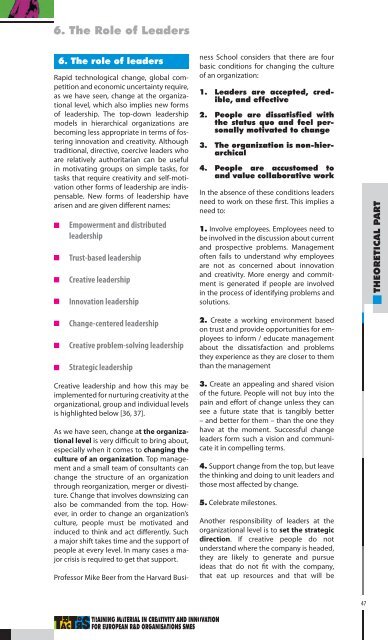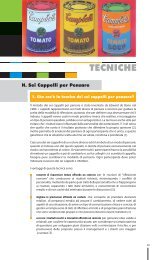Creativity Theory - TRaining MAterial in Creativity and InnovaTion ...
Creativity Theory - TRaining MAterial in Creativity and InnovaTion ...
Creativity Theory - TRaining MAterial in Creativity and InnovaTion ...
You also want an ePaper? Increase the reach of your titles
YUMPU automatically turns print PDFs into web optimized ePapers that Google loves.
6. The Role of Leaders<br />
6. The role of leaders<br />
Rapid technological change, global competition<br />
<strong>and</strong> economic uncerta<strong>in</strong>ty require,<br />
as we have seen, change at the organizational<br />
level, which also implies new forms<br />
of leadership. The top-down leadership<br />
models <strong>in</strong> hierarchical organizations are<br />
becom<strong>in</strong>g less appropriate <strong>in</strong> terms of foster<strong>in</strong>g<br />
<strong>in</strong>novation <strong>and</strong> creativity. Although<br />
traditional, directive, coercive leaders who<br />
are relatively authoritarian can be useful<br />
<strong>in</strong> motivat<strong>in</strong>g groups on simple tasks, for<br />
tasks that require creativity <strong>and</strong> self-motivation<br />
other forms of leadership are <strong>in</strong>dispensable.<br />
New forms of leadership have<br />
arisen <strong>and</strong> are given different names:<br />
• Empowerment <strong>and</strong> distributed<br />
leadership<br />
• Trust-based leadership<br />
• Creative leadership<br />
• Innovation leadership<br />
• Change-centered leadership<br />
• Creative problem-solv<strong>in</strong>g leadership<br />
• Strategic leadership<br />
Creative leadership <strong>and</strong> how this may be<br />
implemented for nurtur<strong>in</strong>g creativity at the<br />
organizational, group <strong>and</strong> <strong>in</strong>dividual levels<br />
is highlighted below [36, 37].<br />
As we have seen, change at the organizational<br />
level is very difficult to br<strong>in</strong>g about,<br />
especially when it comes to chang<strong>in</strong>g the<br />
culture of an organization. Top management<br />
<strong>and</strong> a small team of consultants can<br />
change the structure of an organization<br />
through reorganization, merger or divestiture.<br />
Change that <strong>in</strong>volves downsiz<strong>in</strong>g can<br />
also be comm<strong>and</strong>ed from the top. However,<br />
<strong>in</strong> order to change an organization’s<br />
culture, people must be motivated <strong>and</strong><br />
<strong>in</strong>duced to th<strong>in</strong>k <strong>and</strong> act differently. Such<br />
a major shift takes time <strong>and</strong> the support of<br />
people at every level. In many cases a major<br />
crisis is required to get that support.<br />
Professor Mike Beer from the Harvard Busi-<br />
ness School considers that there are four<br />
basic conditions for chang<strong>in</strong>g the culture<br />
of an organization:<br />
1. Leaders are accepted, credible,<br />
<strong>and</strong> effective<br />
2. People are dissatisfied with<br />
the status quo <strong>and</strong> feel personally<br />
motivated to change<br />
3. The organization is non-hierarchical<br />
4. People are accustomed to<br />
<strong>and</strong> value collaborative work<br />
In the absence of these conditions leaders<br />
need to work on these first. This implies a<br />
need to:<br />
1. Involve employees. Employees need to<br />
be <strong>in</strong>volved <strong>in</strong> the discussion about current<br />
<strong>and</strong> prospective problems. Management<br />
often fails to underst<strong>and</strong> why employees<br />
are not as concerned about <strong>in</strong>novation<br />
<strong>and</strong> creativity. More energy <strong>and</strong> commitment<br />
is generated if people are <strong>in</strong>volved<br />
<strong>in</strong> the process of identify<strong>in</strong>g problems <strong>and</strong><br />
solutions.<br />
2. Create a work<strong>in</strong>g environment based<br />
on trust <strong>and</strong> provide opportunities for employees<br />
to <strong>in</strong>form / educate management<br />
about the dissatisfaction <strong>and</strong> problems<br />
they experience as they are closer to them<br />
than the management<br />
3. Create an appeal<strong>in</strong>g <strong>and</strong> shared vision<br />
of the future. People will not buy <strong>in</strong>to the<br />
pa<strong>in</strong> <strong>and</strong> effort of change unless they can<br />
see a future state that is tangibly better<br />
– <strong>and</strong> better for them – than the one they<br />
have at the moment. Successful change<br />
leaders form such a vision <strong>and</strong> communicate<br />
it <strong>in</strong> compell<strong>in</strong>g terms.<br />
4. Support change from the top, but leave<br />
the th<strong>in</strong>k<strong>in</strong>g <strong>and</strong> do<strong>in</strong>g to unit leaders <strong>and</strong><br />
those most affected by change.<br />
5. Celebrate milestones.<br />
Another responsibility of leaders at the<br />
organizational level is to set the strategic<br />
direction. If creative people do not<br />
underst<strong>and</strong> where the company is headed,<br />
they are likely to generate <strong>and</strong> pursue<br />
ideas that do not fit with the company,<br />
that eat up resources <strong>and</strong> that will be<br />
47<br />
THEORETICAL PART



